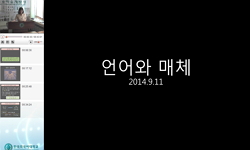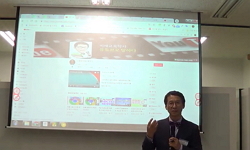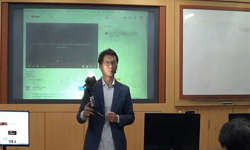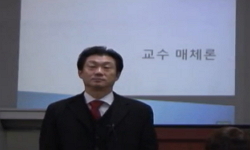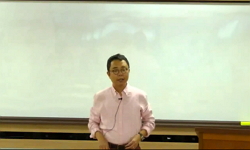현대 사회의 학생들은 다양한 매체에 노출되어 있다. 만화, 영화, 텔레비전, 인터넷 등의 매체에 익숙한 학생들은 글 읽기에 흥미를 잃어가고 있으며, 읽기 능력 또한 저하되어가고 있다. 읽...
http://chineseinput.net/에서 pinyin(병음)방식으로 중국어를 변환할 수 있습니다.
변환된 중국어를 복사하여 사용하시면 됩니다.
- 中文 을 입력하시려면 zhongwen을 입력하시고 space를누르시면됩니다.
- 北京 을 입력하시려면 beijing을 입력하시고 space를 누르시면 됩니다.
https://www.riss.kr/link?id=T8616230
- 저자
-
발행사항
서울 : 연세대학교 교육대학원, 2003
-
학위논문사항
학위논문(석사)-- 연세대학교 교육대학원: 국어교육 전공 2003. 2
-
발행연도
2003
-
작성언어
한국어
- 주제어
-
KDC
376.6481 판사항(4)
-
발행국(도시)
서울
-
형태사항
v, 103p. : 삽도 ; 26 cm.
-
일반주기명
지도교수: 설성경
- 소장기관
-
0
상세조회 -
0
다운로드
부가정보
국문 초록 (Abstract)
현대 사회의 학생들은 다양한 매체에 노출되어 있다. 만화, 영화, 텔레비전, 인터넷 등의 매체에 익숙한 학생들은 글 읽기에 흥미를 잃어가고 있으며, 읽기 능력 또한 저하되어가고 있다. 읽기 영역 중 특히 고전문학은 어려운 한자, 시대적인 거리감, 문화적 차이 등의 이유로 학생들이 어렵게 느끼는 영역이다.
고전문학을 가르치고 배우는 이유는 선인들의 정신 세계를 파악하고, 민족 문학의 정수를 배우며, 민족 문화의 전통을 계승 발전시키고, 오늘의 삶을 풍요하게 함에 있다. 고전작품을 통하여 그 밑바탕에 흐르는 정서와 감정을 이해하고, 이것을 바탕으로 새로운 문학을 창조하는 밑거름이 되도록 하는 것이 고전을 공부하는 이유이다.
그 동안의 고전문학 수업은 표현상의 특징, 자구 해석 등 별표 치고 밑줄 그으며 외우는 식의 주입식 수업이었다. 이러한 수업 방법은 학생들에게 고전 문학을 시험을 위한 부담으로 느끼게 할 뿐, 고전문학에 대한 흥미를 느끼게 할 수는 없었다. 고전문학의 가치를 학생들에게 제대로 전달하기 위해서는 무엇보다 시간적 거리를 극복하고, 학생들이 고전문학을 친숙하고 흥미 있는 것으로 받아들이도록 해야 한다. 활자매체보다 영상매체에 친근감을 느끼는 학생들에게 효과적으로 문학교육을 하기 위해서는 교과서에만 얽매일 것인 아니라 영상매체 자료도 폭넓게 활용해야 한다. 다양한 매체 중 그 단원의 수업 목표를 가장 효과적으로 도달할 수 있는 매체를 선정하여 학생들의 흥미와 관심을 유도해내도록 해야 한다.
본 연구는 만화, 영화, 비디오, 인터넷 등 학생들에게 친숙한 다양한 매체를 수업에 이용하여 학생들이 흥미를 가지고 능동적으로 고전문학을 감상할 수 있는 구체적인 방법을 모색해보고자 하였다. 본 연구의 목적은 다양한 수업 방법의 개발과 적용을 통해 고전문학 시간을 재미있는 시간으로 만들어 학생들에게 고전문학에 대한 관심과 흥미를 이끌어 내고자 함에 있다. 여기서는 고전문학 작품 중 7차 교육과정 고등학교 국어(상), (하) 교과서에 수록된 <봉산탈춤>, <구운몽>, <허생전>, <관동별곡>, <춘향전>을 중심으로 다양한 매체를 활용하여 학생들의 흥미를 유발할 수 있는 실질적인 지도방안을 모색해 보았다.
<봉산탈춤>은 춤사위와 대사가 어우러지는 문학이다. 따라서 활자매체에만 얽매인다면 반쪽 감상 밖에 될 수 없다. 비디오 감상을 통해 <봉산탈춤>에 대한 이해를 도울 수 있으며, ‘봉산탈춤 보존회’ 사이트를 통한 탈 소개, 춤사위 소개 등을 함께 어우른다면 보다 흥미 있는 수업이 될 수 있다. 인터넷 사이트에는 다양한 정보들이 있으므로 간단한 과제를 주어 학생들 스스로 찾아보게 하는 것도 도움이 될 수 있다. <봉산탈춤>은 기득권인 양반에 대한 서민층의 공격, 조롱의 내용을 담고 있으므로 신문, 잡지, 인터넷 등을 활용해 기득권 세력에 대한 비판, 풍자가 나타난 부분을 찾아보게 하는 것도 의미 있는 수업 방법이다. 이러한 수업은 고전이 옛것으로만 머물러 있지 않고, 현재에 이르기까지 충분히 가치가 있다는 것을 보여줄 수 있다.
<구운몽>은 많은 한자어 때문에 학생들이 매우 어렵게 느끼는 작품이다. 게다가 주인공 성진이 꿈에서 온갖 부귀영화를 누리다가 인생무상을 깨닫는 대목은 많은 학생들이 ‘그게 왜 허무해요?’ 하고 고개를 갸우뚱하며 쉽게 수긍 하지 않는 부분이다. 한자어가 많은 어려운 교과서의 구운몽 텍스트를 배우기에 앞서, 만화 텍스트를 활용한다. 이를 준비학습으로 활용하여 구운몽에 대한 흥미를 유발하도록 한다. 성진이 깨닫는 부귀영화의 헛됨, 인생무상이라는 메시지는 유사한 내용을 다루고 있는 영화를 이용하여 이해를 도울 수 있다. <크리스마스 캐럴>의 주인공 스쿠루지 영감의 경험과 성진의 경험을 비교해 볼 수 있다. 스쿠루지는 성탄절 전야 꿈속에서 과거의 유령, 현재의 유령, 미래의 유령과 만나 순진하고 꿈 많았던 어릴 때 모습, 지독한 구두쇠로 변해버린 현재의 모습, 죽은 후에도 남에게 손가락질 받는 비참한 미래의 자신의 모습을 보고 그 동안 인생을 헛되게 살아왔다는 것을 뼈저리게 느끼게 된다. 결국 스쿠루지는 이러한 체험을 통해 새롭게 변화된 인간으로 탈바꿈하게 된다. 이외에 <패밀리 맨>, <마이 라이프>, <키드>등 비슷한 내용을 담고 있는 영화도 이용한다. 이러한 영화를 수업에 활용하면 <구운몽>을 이해하는 데 도움을 줄 수 있다.
<허생전>은 현실에 대한 대안을 어떻게 효과적으로 제시할 수 있는가 배울 수 있는 단원이다. 준비학습으로 인터넷 검색을 통해 <허생전> 창작 당시의 시대적 배경을 알아보도록 한다. 실학사상의 대두 등 시대상을 스스로 찾아보며 배경지식을 갖출 수 있도록 한다. 신문, <한겨레21>과 같은 잡지, <100분 토론>과 같은 텔레비전 매체 등을 통해 사람들은 현실의 모순을 어떻게 극복해가고, 대안을 어떻게 제시하고 있는지 <허생전>과 비교해보도록 한다.
<관동별곡>은 많은 한자어로 인해 학생들이 보기만 해도 거부감을 갖는 작품이다. 그 동안의 <관동별곡> 수업은 단어의 의미와 문법 기능, 수사적 표현, 단락의 중심 내용 찾기, 여정 외우기 등 주로 지식적인 면을 암기하는 수준에 불과했다. <관동별곡>은 작품을 읽어가면서 작가의 인간적인 면을 함께 느끼고, 여행의 즐거움, 자연과의 교감 등의 재미를 찾을 수 있는 작품이다. 따라서 여정을 따라 함께 관동기행을 하는 느낌을 줄 수 있도록 사진이나 동영상을 적극 이용한다. 교사가 직접 관동 지역을 여행하여 사진이나 비디오 자료를 준비하면 더욱 좋을 것이고, 인터넷 ‘관동별곡’ 기행 사이트를 이용해도 좋다. 이 사이트에는 만폭동, 해금강, 총석정, 삼일포, 망양정 등의 여정이 동영상으로 잘 소개되고 있다. <한국의 美 - 신 관동별곡>와 같은 비디오 자료도 <관동별곡> 이해에 도움이 될 수 있다. <관동별곡> 광고 만들기를 수행평가로 활용하면 학생들이 직접 매체를 제작한다는 재미도 갖게 되고, 여정을 그림이나 글로 정리하면서 <관동별곡>에 대한 기억이 각인될 수 있다.
<춘향전>은 만화, 영화 등 다양한 문화 양상을 계승, 발전 되어왔다. 애니메이션 <성춘향뎐>, 영화 <춘향뎐> 등을 함께 보면서 고전문학의 가치와 민족 문화의 발전, 계승 양상을 생각해 볼 수 있는 기회를 갖게 한다. <춘향전> 신문 만들기도 수행평가로 활용해 본다. 시대적 배경 취재, 광한루 탐방, 춘향이 인물탐구, 이도령에게 쓰는 편지, 변학도 항의 방문, 남원 광고 등 학생들이 창의적으로 신문을 만들어보도록 한다. 매체를 수동적으로 받아들이는 입장에서 발전하여 더욱 적극적으로 사고할 수 있는 힘도 아울러 길러줄 수 있을 것이다.
학생들이 문학 수업에 흥미를 가지고 수업에 적극적으로 참여하게 하기 위해서는 작품 자체를 감상하며 그 속에서 즐거움을 느낄 수 있도록 해야 한다. 학생들이 흥미를 가지고 수업에 참여할 수 있도록 다양한 수업 방안을 모색해야 하며, 그것을 교사 간에 서로 공유할 수 있는 여건이 정착되어야 한다.
다국어 초록 (Multilingual Abstract)
Students in the modern society are widely exposed to a variety of media. They are so deeply accustomed to these media that they are easily inclined to lose some interest in reading and their reading ability is also decreasing. Especially, classical li...
Students in the modern society are widely exposed to a variety of media. They are so deeply accustomed to these media that they are easily inclined to lose some interest in reading and their reading ability is also decreasing. Especially, classical literature is one of the most difficult area to learn to students due to its Chinese characters, time distance, and cultural difference.
The reason to learn classical literature is to understand the spiritual world of our ancestors, to learn the core of the literature, to succeed to our tradition, and to rich today's life. Through reading classical literature, students can understand the deep-rooted emotions and feelings of us and create a new version of literature.
For a long time, classical literature has been taught through cramming and memorizing expressions and character translations. This kind of teaching lowers students' desire for learning classical literature as well as puts pressure about testing of it. To convey the value of classical literature, teachers should try to have students overcome the time distance, making them familiar and interested in it. For that, teachers should employ audio/video media widely, not just limited to textbooks, and choose the most suitable medium to attain the goal of each chapter.
This study is trying to find specific methods to contact classical literature positively and interestingly, using various media such as cartoons, movies, videos, and the Internet. The goal of this study is to develop various classroom methods and to make classical literature lessons interesting and exciting applying those methods. Here we'll see a variety of media-based classroom techniques, focusing on five famous classical works which are shown on the textbooks of the 7th curriculum.
<Bongsan Mask Dance> is a work to show a perfect combination of dances and speeches. Students can understand <Bongsan Mask Dance> through video watching. Thousands of Internet sites introducing masks and dances can also be an useful source. Another way to use the Internet is to give out simple tasks to students and let them find out relevant information for themselves. <Bongsan Mask Dance> is about the public's attacks and mockery against the privileged people 'yangban.' Therefore, it would be a meaningful classroom technique for students themselves to search the criticism and satire against 'yangban,' checking newspapers, magazines, and the Internet. This kind of teaching can make them know that classical literature has plenty of values even now.
<Guwoonmong> is a work that students feel difficulty with due to abundant Chinese characters. Especially the part where the main character 'Sungjin' feels 'life is in vain' after all his life's richness gives students a confusion, questioning why he feels in that way. To help their understanding, it will be a good way to use a cartoon text before learning difficult original text. It will help to elicit students' interest about the text. Some movies which have similar messages, that is the vain of richness, can also be used. The old man 'Scrooge' in <A Christmas Carol> has a similar experience with Sungjin. In a dream before the Christmas day, he met the ghost of past, present, and future and saw the changes of himself from a pure child to a stingy man, and finally to a miserable being who is pointed by others. And he feels like Sungjin 'life is in vain.' In the end, Scrooge became a new person. Besides, <A Family Man>,<My Life>, and <The Kid> contain similar messages. The message of <Guwoonmong> can be conveyed using those movies.
<Heosaengjeon> is a work that can teach students how to solve problems in the daily lives. As a warm-up, students try to find background information for themselves. Comparing <Heosaengjeon> with newspapers, magazines like <hangeorae 21>, and televisin program like <100 minutes Discussion>, students can learn how to overcome life's contradictions and how to suggest good solutions.
<Kwandongbeolgok> is one of the most difficult works. Until now, <Kwandongbeolgok> has been taught in the level of memorizing knowledge and information. However, it is a piece we should study, sympathizing the author's personal feeling, pleasure of travelling, and rapport with nature. Therefore, teachers should actively use pictures or motion-pictures to convey those. If teachers can make materials travelling and taking pictures of that areas, it couldn't be better. Teachers can also use some travelling sites on the Internet. These sites are introducing famous places very well. The video tape <New Kwandongbeolgok - Korea's Beauty> is a good source for helping students' understanding. In addition, performative evaluation to use 'Making Ads' is a good example to be used. Making ads, students can have a great pleasure to make their own works.
<Chunhangjeon> has been developed through a lot of versions like cartoons and movies. An animation <Sung-Chunhangjeon> or a movie <Chunhangjeon> can be accompanied to the classroom teaching. Making <Chunhangjeon> newspapers can also be employed for the performative evaluation. Students will recall creative ideas such as Chunhang Study, the letter for Mr. Lee, and Namwon advertisements and so on. This type of creative works will change students from a passive being who accepts given information to a positive one who think actively.
To make students participate in classical literature classes, students themselves should study the work and feel the pleasure in it. For that, teachers should employ a variety of activities and build a base of sharing information each other.
목차 (Table of Contents)
- 차례 = i
- 국문요약 = ii
- I. 서론 = 1
- 1. 연구의 필요성 및 목적 = 1
- 2. 연구 범위와 방법 = 7
- 차례 = i
- 국문요약 = ii
- I. 서론 = 1
- 1. 연구의 필요성 및 목적 = 1
- 2. 연구 범위와 방법 = 7
- 3. 연구사 검토 = 8
- II. 고전문학 교육의 의의 = 11
- 1. 고전문학 교육의 의의 = 11
- 2. 고전문학 교육의 반성 = 14
- 3. 매체 활용 교육의 필요성 = 23
- III. 고전문학 교수-학습 방법의 개선 방안 = 33
- 1. <봉산탈춤> 교수-학습 방법 = 33
- 2. <구운몽> 교수-학습 방법 = 50
- 3. <허생전> 교수-학습 방법 = 63
- 4. <관동별곡> 교수-학습 방법 = 71
- 5. <춘향전> 교수-학습 방법 = 80
- IV. 결론 = 93
- 참고 문헌 = 96
- ABSTRACT = 100





